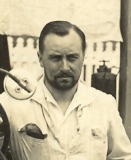

| site search byfreefind | |||
|
|||
As far as we can ascertain, Chenard Senechal arose as a result of a partnership between Ms. Chenard of the Chenard et Walcker organization and Robert Senechal who was Chenard Walcker’s principal race driver in the early 1920’s, having won many endurance races for Chenard Walcker, including Le Mans. The relationship must have been a good one as Robert Seneschal manufactured his own small lightweight sports cars using 900cc Ruby engines (among others) in a corner of the Chenard Walcker factory, he raced these very successfully under his own name. The partnership which resulted in the Chenard Senechal cars appears to have only lasted several years, possibly as little as two, so very few cars were produced. I recently discovered the engine number on my car, it is 27. I have been unable to find a chassis number anywhere on the car although a number is quoted on the original Australian registration certificate which I still have, I am shown on this certificate as the second last owner, the last being the person I sold the car to and from whom Bruce purchased the car after it was damaged in the fire.
I think the Chenard Senechal was loosely based on the 7CV Chenard Walcker of about the same era, but with a 1500cc engine, longer wheelbase and the short spoked wire wheels you see in the photos. A few of the ‘bits and pieces’ on my car are pure Chenard Walcker such as the dashboard light, the brass hubcaps and the radiator surround. As I said, the engine is a 1500cc side valve with a single Solex side draught carby, four speed gearbox (reverse H pattern) and very large four wheel brakes. I know a fellow just out of Geelong in Victoria who has a Chenard Walcker roadster of about the same year as my car. It is similar to mine however the motor, although the same capacity, is very much bigger externally and it has the solid steel disc wheels and shorter wheelbase. It looks very heavy and mundane.
Courtesie
Graeme Love
In 1922, a Grand Sport with a 975 cc engine with overhead valves was unveiled and in 1923 a model was launched with a 1100 cc engine. The cars were perfect for racing. A Senechal won the Boulogne Grand Prix in 1923 and 1924 and the famous Bol d'Or in 1923, 1924 and 1925. In 1926, the company was taken over by Chenard & Walcker.
In that same year, there were three basic models in the range: the small Voiturette, the Sport and the Grand Sport. All the cars were powered by a 972 cc engine made by Chenard & Walcker. The Voiturette had a side-valve engine, both the other engines had overhead valves. Senechals were manufactured until 1929. From that moment on the company limited itself to its own products.
The complete encyclopedia of Vintage Cars - Rob de la Rive Box


